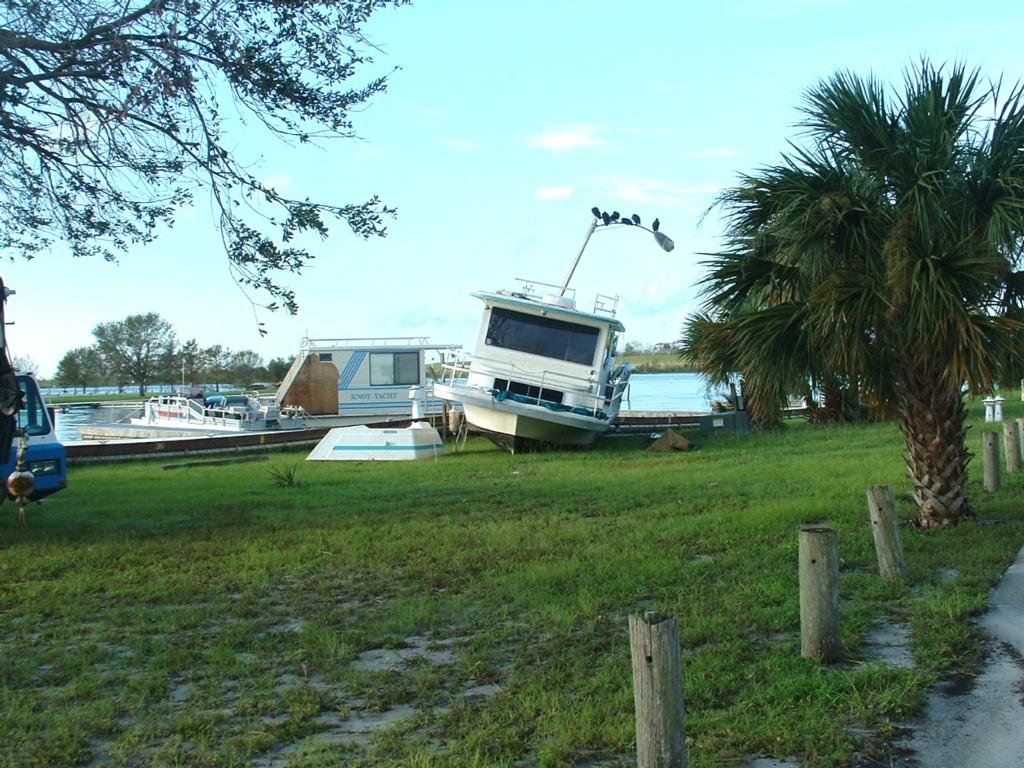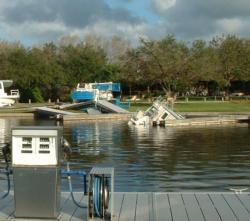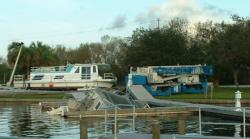Hurricane Alley
FLW Tour pros tell their own storm stories

Editor’s note: This is the first part of a series entitled “Hurricane Alley.” Part two will take a look at the impact hurricanes have had on the tournament fisheries of Lake Okeechobee, Lake Toho and the Mobile Delta.
First there was Charley, then came Frances, then Ivan and Jeanne. In a way, it’s like Mother Nature bore tropical quadruplets.
In a period of seven weeks, the Atlantic Ocean spawned four major hurricanes, each making landfall on Florida.
The aftermath of these catastrophic storms has filled the news. At times it has been difficult to discern whether the pictures on the nightly news were coming from war-torn Iraq or hurricane-torn Florida.
In some way, nearly every one in Florida has been affected by hurricanes recently – including some familiar faces on the FLW Tour.
First came Charley
Hurricane Charley was the first in the line of hurricanes to hit Florida. On Friday, Aug. 13, the storm hit the west coast of Florida centering on the Punta Gorda-Boca Grande area.
FLW Tour pro Sandy Melvin lives in Boca Grande, Fla., where he runs an Orvis fly-fishing shop and guides on the tarpon-rich waters of Boca Grande Pass. However, when Charley roared ashore near his home, Melvin was at the FLW Tour Championship in Birmingham, Ala., working for his sponsors.
“The initial forecast track was due north through the Gulf,” Melvin recalled. “So I wasn’t that concerned. But then it took a turn for the worst. I was standing in the Garmin booth watching Charley on one of Garmin’s new real-time NOAA weather radar units when the storm made a jog to the east – that’s when knew I was in trouble.”
Melvin tried to get an early flight home, but it was too late. Airports in Florida were closed and the only thing headed to his house was a Category 4 hurricane. Only Category 5 hurricanes are more severe, and only two 5s have hit the United States since record-keeping began.
“That’s a pretty sick feeling,” Melvin said, “to sit there and watch a hurricane that is packing winds of 140 mph make landfall right where you live.”
The hurricane hit on Friday afternoon, and Melvin did not return to his house and business until Sunday afternoon.
“I had to drive through Punta Gorda to get home, and it was gut-wrenching to see what Charley had done,” he said. “When I got home, I couldn’t believe how fortunate we were; we missed the eye by just 10 miles.”
Melvin was lucky. His house had some minor damage and his shop suffered some moderate damage, including blown-out windows and awnings.
“What probably saved us more than anything was that the eye went to our south,” Melvin explained. “That gave us offshore winds instead of the onshore winds, which caused the storm surge that pummeled Punta Gorda.”
When Melvin was finally able to get back out on the water in Pine Island Sound, he couldn’t believe what Charley had done to the coast.
“It cut a new pass through Captiva Island (a barrier island), and it stripped the mangroves and other trees from the islands,” he added. “Now all those trees litter the shallow-water flats behind the islands – it’s surreal.”
After Charley came ashore, it headed across the state toward Kissimmee, Fla., where FLW Tour Pro Terry Segraves was, “hugging the plumbing.”
“I’ve never been through anything like that,” said a humbled Segraves several weeks after Charley passed through. “On several occasions (that night) we hunkered down in the laundry room and just prayed everything would be OK. It’s a helpless feeling.”
“If I ever build another house, I’ll build a storm room with reinforced concrete walls and a steel door,” said Segraves. “We had sustained winds in the 100- to 110-mph range and, not to mention, tornadoes, which twisted trees and power poles together like twist ties. When you see all that, it’s pretty scary – you gain a whole new respect for Mother Nature.”
Segraves, like Melvin, was very fortunate.
“I had a little damage to the house from trees, but so did a lot of people,” he said. “It’s really nothing compared to the damage other people suffered right here in my neighborhood. There were trees down on houses everywhere, and it’s estimated that at least one in three homes here in Kissimmee have suffered some kind of damage.”
After the storm passed, Segraves’ nightmare continued.
“The power was out for five days,” he said. “I consider myself to be a pretty tough individual, but by day five I was at the end of my rope.”
Air conditioning was the amenity that Segraves missed the most.
“You could never cool off,” he said. “We did have running water, but a cold shower is only refreshing for so long. The only way to cool off was to sit inside the car and run the A.C. for a few minutes. At night I just laid there praying for a breeze. The whole experience was a reminder of all the things we take for granted.”
After several days without power, Segraves says things got worse.
 “Many folks had generators, but they started having problems because gas was so scarce,” he said. “Five or 10 gallons of gas is not much for a generator that is running all the time for several days.
“Many folks had generators, but they started having problems because gas was so scarce,” he said. “Five or 10 gallons of gas is not much for a generator that is running all the time for several days.
“We lived on hot dogs that week. Everything was closed and there was nowhere to buy food. I had to wait hours just to buy a couple of bags of ice. It was a pretty testy situation, and it’s still going on for a lot of people here in Florida.”
“I saw some tempers flare over gas and ice,” Segraves added. “But what has been refreshing throughout this whole ordeal is how folks in these communities and neighborhoods have really pulled together to help each other out. I now know my neighbors better than I ever have. We have all worked together to get trees off people’s houses and make roads passable again.”
Frances
Before folks in Florida could begin picking up the pieces from Charley, more trouble was brewing on the horizon in the name of Frances.
Frances targeted the east coast of Florida and came ashore on Sept. 5 as a Category 2 storm with winds of 105 mph.
The eye passed within 30 miles of Boca Raton, Fla., where Castrol pro Mike Surman lives.
“We (Surman’s family) were in west Texas visiting relatives when Frances hit,” Surman reported. “To watch (on TV) a hurricane come ashore where you live is a helpless feeling.”
Like Melvin a few weeks before, Surman got lucky and endured “the good side of the storm.”
Just as Charley went to the south of Melvin on Florida’s west coast, giving it northeast winds and less surge, Frances went to the north of Surman on the east coast, giving it northeast winds and less surge.
“Our screened-in porch is blown out and we had some other wind damage, but I’ve got to say we were lucky,” Surman said. “Amazingly, we never lost power, but there were subdivisions right next to ours that were without power for six or seven days.”
After landfall near Stuart, Fla., Frances continued tracking up through the state, giving the Orlando-Kissimmee area a second blow.
“Frances didn’t pack near the punch that Charley did,” Segraves said. “The winds were about 60 to 70 mph. I think there was a little more rain with Frances, but the wind was not near as bad. Once you have been through 100 to 110 mph winds, there’s not much left to blow down. After Frances we were only without power for a couple of hours.”
Ivan
Floridians living along the panhandle coast were largely unscathed by Charley and Frances. But that all changed when Ivan, a Category 3 storm, made landfall near the Alabama-Florida line near Gulf Shores, Ala., on Sept. 16.
It seemed unthinkable: three major hurricanes on all three Florida coasts in less than six weeks. But as Ivan moved closer to the Gulf Coast, there was no time to think because many were scrambling to evacuate.
Skippy pro Jason Kilpatrick of Satsuma, Ala., which is just northwest of Mobile, Ala., was one of those that took no chances with Ivan.
“We left,” Kilpatrick said. “When I was a kid, Frederick went through here and I saw the devastation it caused. I simply did not want to subject my family to that kind of catastrophe, so we went to Tuscaloosa to stay with some friends.”
But evacuating was not easy. Interstates 10 and 65 had become a colossal traffic jam.
“Northbound traffic on I-65 was unreal,” Kilpatrick said. “The lines at the exits and gas stations looked like something out of the movies. There were droves of stopped cars every direction you looked. What normally takes 45 minutes to reach by I-65 took two and a half hours. I finally exited onto a back road and headed west to Tuscaloosa.”
Kilpatrick also escaped major storm damage because of how the storm was positioned when it hit Mobile.
“Right before landfall, Ivan made a tiny jog to the east, and that really saved Mobile from a devastating storm surge,” Kilpatrick said. “But unfortunately, Gulf Shores (Ala.) and Pensacola (Fla.) just got hammered.”
“In order to see the difference of being on two different sides of a hurricane, you only have to go about 45 minutes west from here (Mobile) to Pensacola where the northeast side of the storm hit. It’s just total devastation over there. The surge there was so powerful it washed out portions of the Interstate 10 Bridge going across Escambia Bay.”
Considering that the collapsed portions of the bridge are usually some 12 to 15 feet above the waterline, the storm surge had to be at least that high to knock the bridge out.
“Can you imagine that,” Kilpatrick said, pausing. “A wall of water 15- to 20-foot high. If we (Mobile) had gotten that side of the storm and that kind of surge, there’s no telling what would have happened.”
After Ivan, Florida reeled in the devastation of hurricanes on all three coasts, but the horror was still not over.
On Sept. 26 Hurricane Jeanne, following almost the exact same path as Frances, came ashore as a Category 3 storm.
“It’s spooky how Jeanne took almost the exact same path as Frances,” Surman said. “It’s like they were twins.
“The irony of Jeanne is that those who did not have their damage from Frances fixed were almost better off, because they would have just lost everything again. I know some folks that worked overtime to have $100,000 worth of repairs done after Frances, only to have it all blown away again in Jeanne.”
Segraves noted that by the time Jeanne rolled into Kissimmee, the area simply had nothing else left for the wind to blow down.
BFGoodrich Tires pro Scott Martin of Clewiston, Fla., left town.
“We stayed in Clewiston for Frances, but we went to my dad’s over in Naples for Jeanne,” Martin said. “The thing with hurricanes, like I learned with Frances, is that once you batten down the hatches and ride one out, you are stuck there, usually without power, for a long time.
“At least over in Naples (Fla.) we had power and could go out to eat and enjoy some time with the family instead of being all stressed out about not having power or water.”
FLW Tour pro Billy Bowen of Ocala, Fla., said Jeanne – of all the hurricanes – was the one that really gave his area in central Florida a wallop.
“It’s like Frances set us up, and Jeanne wiped us out,” Bowen said. “I was born and raised in Ocala, and I’ve never been through anything like that. After so much rain with those other storms, the ground was sopping wet, and the winds from Jeanne uprooted big trees all over the place.”
Bowen, like many, went four or five days without power.
“I’ve learned a lot about hurricanes in the last month, and the only advice I can give is to get in your car and leave before one hits,” he added. “They are scary and being without power is no fun.”
Even FLW Outdoors in Kentucky became familiar with Jeanne as the organization was forced to postpone the Gator Division BFL Super Tournament on Lake Okeechobee.
“An impending hurricane is a situation that would have put our anglers in harm’s way,” said BFL Tournament Director Ron Lappin. “The wind forecast for the first day of the event was 25 to 55 mph. So we postponed the event until the following weekend.”
But Jeanne left the town of Okeechobee in such bad shape, it looked doubtful that the tournament could be held there at all.
“The town of Okeechobee had 104-mph winds,” Lappin said. “Jeanne really caused a lot of damage, not only in the town of Okeechobee, but also at Okee-Tantie Park, where big trees were down, docks and house boats had floated up into the parking lot, and there was no power.”
However, the town of Okeechobee realized that hosting such a large tournament would provide much-needed income to help get the town back on its feet again. They simply could not afford to let the BFL Super Tournament be held somewhere else.
“I cannot even begin to tell you what those folks at the Okeechobee County Tourism Commission did to make the tournament happen,” Lappin reported. “Kathy Scott, the director of tourism, and her crew worked tirelessly to make sure the facilities were up and running for our fishermen. Trees had to be removed, the county came in and repaired the ramps, and on Friday afternoon before the tournament started, the power was restored.
“They even had ice and drinks for the anglers on Saturday morning. Not only did the tournament come off without a hitch, they still rolled out the red carpet for us.”
And when the anglers returned for the weigh-in, it looked as if the bass on Lake Okeechobee had survived the storms just fine. There were 200 limits weighed in and the winning weight on the pro side was a two-day total of 37 pounds, 12 ounces.
